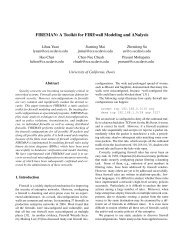You also want an ePaper? Increase the reach of your titles
YUMPU automatically turns print PDFs into web optimized ePapers that Google loves.
2.3. Optimal trees in case of single member compromise<br />
(a1, . . . , ak, 4). It is clear that neither the sum nor the product of the elements changes with this<br />
transformation. In addition, we can use the definition of R to get<br />
and<br />
N 2 · R(A) = ((a1 − 1) · a2 · . . . · ak · 2 · 2) 2 + . . . + ((ak − 1) · 2 · 2) 2 +<br />
((2 − 1) · 2) 2 + (2 − 1) 2 + 1<br />
N 2 · R(A ′ ) = ((a1 − 1) · a2 · . . . · ak · 4) 2 + . . . + ((ak − 1) · 4) 2 +<br />
(4 − 1) 2 + 1<br />
Thus, R(A ′ ) − R(A) = 1<br />
N 2 (9 − 4 − 1) > 0, which means that A ′ is better than A.<br />
Now, that is proven that the lemma is also true for b ′ 1 ∈ {2, 3, 4}:<br />
b ′ 1 = 2: Since B ′ is an ordered vector where b ′ 1 is the largest element, it follows that every<br />
element of B ′ is 2, and thus, N is a power of 2. From Lemma 2, R(B ′ ) < (1− 1<br />
2 )2 + 4<br />
3·22 = 7<br />
12<br />
and R(B) > (1 − 1<br />
b1 )2 . It is easy to see that (1 − 1<br />
b1 )2 ≥ 7<br />
12 if b1<br />
1 ≥<br />
1− √ = 4.23. Since<br />
7<br />
12<br />
b1 > b ′ 1, the remaining cases are b1 = 3 and b1 = 4. However, b1 = 3 cannot be the case,<br />
because N is a power of 2. If b1 = 4, then B can be obtained from B ′ by joining pairs of<br />
2s into 4s and then ordering the elements. However, according to the observation above and<br />
Lemma 1, both operations improve the vector. It follows that R(B) ≥ R(B ′ ) must hold.<br />
b ′ 1 = 3: From Lemma 2, R(B ′ ) < (1 − 1<br />
3 )2 + 4<br />
3·32 = 16<br />
27<br />
that (1 − 1<br />
b1 )2 ≥ 16<br />
27 if b1 ≥<br />
In this case, the vectors are as follows:<br />
and R(B) > (1 − 1<br />
b1 )2 . It is easy to see<br />
9<br />
9−4· √ 3 = 4.34. Since b1 > b ′ 1, the only remaining case is b1 = 4.<br />
<br />
B = ( 2 2 , . . . , 2 2 ,<br />
i<br />
B ′ <br />
= ( 3, . . . , 3,<br />
j<br />
j<br />
<br />
3, . . . , 3,<br />
2i+k<br />
<br />
2, . . . , 2)<br />
k<br />
<br />
2, . . . , 2)<br />
where i, j ≥ 1 and k ≥ 0. This means that B can be obtained from B ′ by joining i pairs of<br />
2s into 4s and then ordering the elements. However, as we saw earlier, both joining 2s into<br />
4s and ordering the elements improve the vector, and thus, R(B) ≥ R(B ′ ) must hold.<br />
b ′ 1 = 4: Since B ′ is an ordered vector where b ′ 1 is the largest element, it follows that N is not<br />
divisible by 5. From Lemma 2, R(B ′ ) < (1 − 1<br />
4 )2 + 4<br />
3·42 = 31<br />
48<br />
easy to see that (1 − 1<br />
b1 )2 ≥ 31<br />
48 if b1 ≥<br />
1<br />
1− √ 31<br />
48<br />
and R(B) > (1 − 1<br />
b1 )2 . It is<br />
= 5.09. Since b1 > b ′ 1, the remaining case is<br />
b1 = 5. However, b1 = 5 cannot be the case, because N is not divisible by 5. ⋄<br />
Lemma 3 states that given two branching factor vectors, the one with the larger first element is<br />
always at least as good as the other. The next lemma generalizes this result by stating that given<br />
two branching factor vectors the first j elements of which are equal, the vector with the larger<br />
(j + 1)-st element is always at least as good as the other.<br />
Lemma 4. Let N and Dmax be the total number of members and the upper bound on the maximum<br />
authentication delay, respectively. Moreover, let B = (b1, b2, . . . , bℓ) and B ′ = (b ′ 1, b ′ 2, . . . , b ′ ℓ ′)<br />
be two sorted branching factor vectors such that bi = b ′ i for all 1 ≤ i ≤ j for some j < min(ℓ, ℓ′ ),<br />
and both B and B ′ satisfy the constraints of the optimization problem defined above. Then,<br />
bj+1 > b ′ j+1 implies R(B) ≥ R(B′ ).<br />
17












